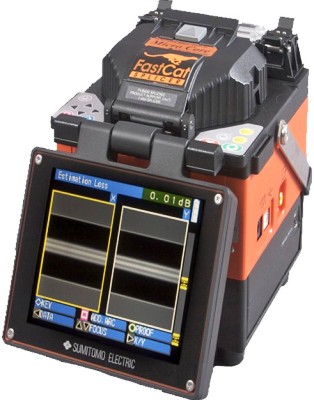
|
|
The Sumitomo Type-39 FastCat Core Alignment Fusion Splicer is the industry’s first splicer to feature a Dual-Automatic Heater System featuring Auto Start Heater and Auto Start Splice functions. The Type-39 FastCat’s advanced electronic design, which accommodates the built-in dual heating system and simultaneous operation, reduces the bottle neck of “heater wait time” by 88%. With an individual heater cycle time of only 30 seconds (60mm Fiber Protection Sleeves) and a splice cycle of only 9 seconds, the FastCat improves splicing efficiency by 70%. The Type-39 utilizes precision High Resolution Direct Core Monitoring (HDCM) technology and is a fully automatic, highly portable, self-contained instrument for creating quick, effortless, and repeatable low-loss optical fiber splices in any environment with a typical splice loss of only .02(dB) for identical single-mode fiber. It is designed to work with virtually all fiber types including single-mode, multimode, dispersion shifted and other specialty fibers, as well as facilitating the breakthrough Lynx2 Splice-On Connector technology for fast, precise, customized field terminations. Specifications. Fiber Requirement: Silica Glass. Coating Diameter: 250 and 900µm. Cladding Diameter: 80 to 150µm. Cleave Length: 10mm. Typical Splice Loss, Identical Fibers: SMF: 0.02dB, MMF: 0.01dB, NZ-DSF: 0.04dB. Number of Fiber Profiles: 48 Customizable. Number of Pre-Installed Heater Profiles: 20 Customizable. Internal Splice Data Storage: 10,000. Monitor Position: Multiple Position Monitor. Dual Independent Heaters, Each Heater: 25 seconds 40mm sleeve, 30 seconds 60mm sleeve. Typical Splice Time: 9 Seconds Splice Cycle Time. Return Loss: <-70dB. Proof Test: Internal 200g (Std.), 400g (Optional). Attenuation Splicing: Up to 15dB in increments of 0.01db.
|